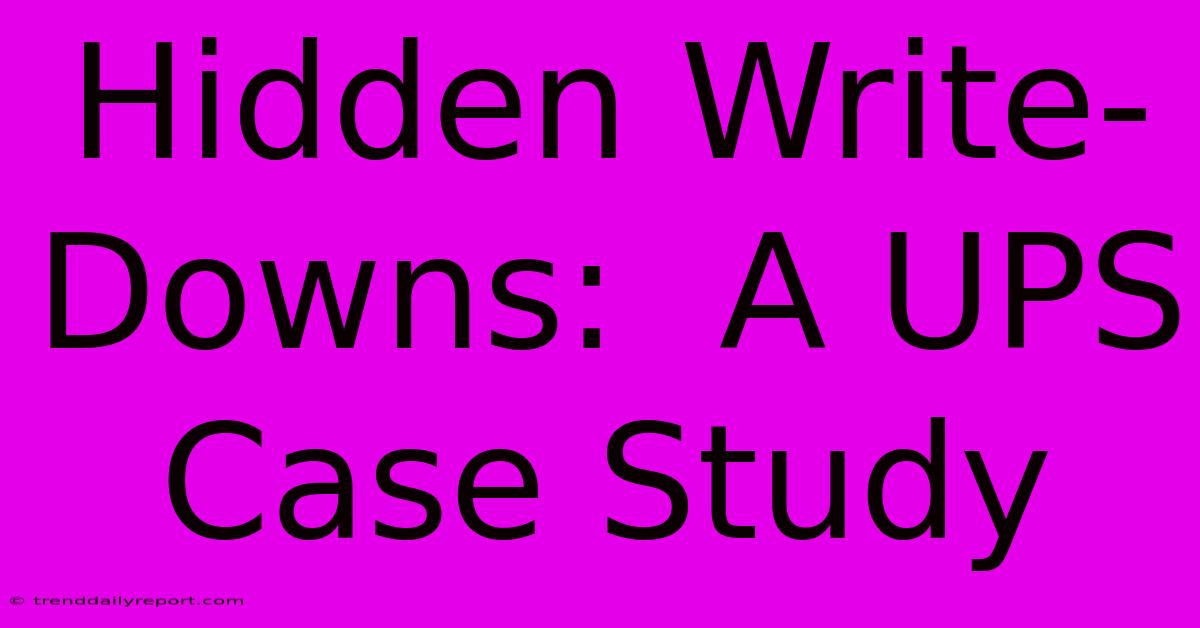Hidden Write-Downs: A UPS Case Study

Discover more detailed and exciting information on our website. Click the link below to start your adventure: Visit Best Website Hidden Write-Downs: A UPS Case Study. Don't miss out!
Table of Contents
Hidden Write-Downs: A UPS Case Study – My Lessons Learned the Hard Way
Hey everyone, let's talk about something kinda boring, but super important for anyone who follows the stock market or is interested in accounting – write-downs. I know, I know, sounds like a snoozefest, right? But trust me, understanding write-downs, especially hidden ones, can save you a whole lotta heartache. And I'm speaking from experience – painful, expensive experience.
I'll never forget that time I almost got totally wiped out investing in… UPS. Yep, United Parcel Service. Who woulda thought? Seemed like a safe bet, right? A giant, established company delivering packages. Solid as a rock, I figured. Wrong. Dead wrong.
The UPS Surprise
I'd been following UPS's stock for ages. Their earnings reports always looked pretty good, at least on the surface. Solid revenue growth, decent profit margins – the whole nine yards. I was so confident, I practically threw all my savings into it. Then, BAM! The bottom fell out. Turns out, UPS had been quietly taking some massive write-downs on some of their assets, mostly related to their international operations and outdated technology. These weren't clearly stated in their initial earnings reports. They were buried deep within the footnotes – the kinda stuff most investors, including myself at the time, just gloss over.
What's a write-down anyway? In simple terms, it means a company has to reduce the value of an asset on its balance sheet because it's worth less than they originally thought. This could be because of obsolescence, impairment, or market changes. Think of it like realizing that your prized collection of Beanie Babies isn't worth as much as you thought it was. Ouch.
Spotting the Hidden Clues (Before You Lose Your Shirt)
My huge mistake was not digging deep enough into the financial statements. I was looking at the top-line numbers, the catchy headlines in the press releases – the stuff designed to make the company look good. I failed to look beyond the surface.
Here’s what I learned the hard way, and what you should be looking for:
- Dig into the footnotes: Seriously, this is gold. The real meat of the story is often hidden in the fine print. I know, it's tedious, but crucial.
- Pay attention to changes in accounting policies: Did they suddenly switch to a different depreciation method? That could signal something fishy.
- Look for unusual gains or losses: Large, unexplained gains or losses can sometimes mask write-downs. You need to be a detective, people.
- Compare to competitors: How does UPS's performance compare to FedEx or other logistics companies? Are there discrepancies you can't explain?
- Don't just rely on the news: Financial news often focuses on the positive. Do your own thorough investigation. This is not a game.
The UPS situation taught me a valuable lesson: don't trust blindly. Even seemingly stable companies can have hidden problems. Always do your due diligence, no matter how tempting the investment looks. And yes, read those darn footnotes! Trust me, it's way better than losing your investment.
The Silver Lining (Eventually)
Even though I lost a chunk of my savings, I didn't give up. I used this experience as a learning opportunity. I became obsessed with understanding financial statements. I learned to read between the lines, and I became far more critical in my investment decisions. It wasn't fun, but it was a valuable lesson.
It's kinda like learning to ride a bike. You're gonna fall a few times, scrape your knees, and maybe even cry a little. But eventually, you'll learn to balance and ride with confidence. Investing is similar. There will be bumps in the road, but the key is to learn from your mistakes and keep moving forward.
So, remember the UPS case study. It's a prime example of how hidden write-downs can sink even the seemingly safest investments. Do your homework; it might save your portfolio.
Remember, always read the fine print, friends!

Thank you for visiting our website wich cover about Hidden Write-Downs: A UPS Case Study. We hope the information provided has been useful to you. Feel free to contact us if you have any questions or need further assistance. See you next time and dont miss to bookmark.
Featured Posts
-
Hecs Refund Program Check Your Eligibility
Nov 27, 2024
-
Swifts Eras Tour Vancouver Economic Impact
Nov 27, 2024
-
Barcelonas Dominant 3 0 Ucl Highlights
Nov 27, 2024
-
Mc Gregors Image Removed From Whiskey
Nov 27, 2024
-
Pet Influencer Mollys Account Shut Down
Nov 27, 2024
